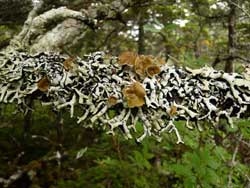More than a century after the Gold Rush, mining an historical park’s lichen diversity

In article appearing in October in the journal The Bryologist, a team of researchers from Austria, Norway, Spain and the United States report the highest diversity of lichens found anywhere on the North American continent from the Klondike Gold Rush National Historical Park (KLGO).
Located at the headwaters of the longest fjord in southeast Alaska, an area of only 13,000 acres (53 square kilometers) harbors the highest number of lichens and associated fungi ever found in an area of comparable size: 766 species in two slivers of land along the 1898-99 Gold Rush trails out of Skagway and Dyea, Alaska.
While lichen surveys have been completed for only a few national parks in North America, the Klondike survey, funded by the U.S. National Park Service, is notable for edging out some much larger National Parks, including 300 more species than either Yellowstone, Glacier and Great Smoky Mountains National Parks. Indeed, the Klondike study has the ninth highest number of species of any lichen survey ever conducted worldwide in an area under 10,000 square kilometers.
Perhaps most surprisingly, however, fully seventy-five species – nearly 10% of all species found – are candidates for being new to science because they do not match any known species in a global literature review. Among the notable finds, the authors discovered a new genus of lichens with similarities to rock-dwelling genus Steinera in New Zealand and subantarctic islands. They name the genus Steineropsis, meaning ‘looking like Steinera’. The authors describe another species, Coccotrema hahriae, in honor of Meg Hahr, the former natural resources program manager of Klondike Gold Rush National Historical Park, who passed away last year. Altogether five new species for science are described in the current paper.
“This is like uncovering a biodiversity hotspot on the order of some of the lost forests in New Guinea or Mozambique” says the principal investigator, Toby Spribille (shpruh-BILL-uh), a Montana, U.S.A. native and current graduate student at the University of Graz, Austria. Spribille, together with his collaborators from the Spanish National Research Council, Madrid, and the University of Bergen, Norway, also highlight the significance of finding a biodiversity hotspot at high latitudes. “It’s generally assumed biodiversity declines as you move towards the poles, but this has so far not been the case for lichens”. He notes that lichens, which are a symbiosis between a fungus and an alga, have been shown to reach optimum growth conditions at cool temperatures and thus could be expected to peak in diversity in cool climates. The Klondike study also includes a first-ever overview of top lichen biodiversity studies worldwide. This showed that all of the other top lichen inventories in the world to date have come from middle to high latitudes, unlike in many other organism groups, in which the highest diversity is typically in the tropics.
“This is important information to tie into climate change research”, says Spribille. “The high latitudes are where the warming in the next century is expected to be the greatest, and while single species like the polar bear are considered threatened by the loss of arctic habitats, climate change is not usually getting translated into potential effects on large numbers of species.” This view may begin to change, he predicts, as scientists discover that peak biodiversity for groups such as lichens may historically reside in the cool, damp forests and tundra of the north.
Article: Lichens and lichenicolous fungi of the Klondike Gold Rush National Historic Park, Alaska, U.S.A. The Bryologist 113(3): 439-515. Will appear in print on or about Oct. 18, 2010 (Allen Press; http://www.bioone.org/toc/bryo/113/3)
For more information contact: Dave Schirokauer, 907-983-9228; dave_schirokauer@nps.gov
or: Toby Spribille: tspribi@gwdg.de
Media Contact
All latest news from the category: Life Sciences and Chemistry
Articles and reports from the Life Sciences and chemistry area deal with applied and basic research into modern biology, chemistry and human medicine.
Valuable information can be found on a range of life sciences fields including bacteriology, biochemistry, bionics, bioinformatics, biophysics, biotechnology, genetics, geobotany, human biology, marine biology, microbiology, molecular biology, cellular biology, zoology, bioinorganic chemistry, microchemistry and environmental chemistry.
Newest articles

High-energy-density aqueous battery based on halogen multi-electron transfer
Traditional non-aqueous lithium-ion batteries have a high energy density, but their safety is compromised due to the flammable organic electrolytes they utilize. Aqueous batteries use water as the solvent for…

First-ever combined heart pump and pig kidney transplant
…gives new hope to patient with terminal illness. Surgeons at NYU Langone Health performed the first-ever combined mechanical heart pump and gene-edited pig kidney transplant surgery in a 54-year-old woman…

Biophysics: Testing how well biomarkers work
LMU researchers have developed a method to determine how reliably target proteins can be labeled using super-resolution fluorescence microscopy. Modern microscopy techniques make it possible to examine the inner workings…





















